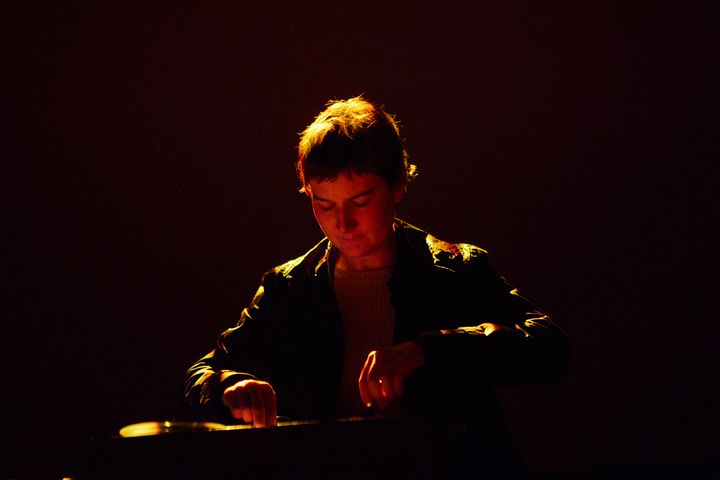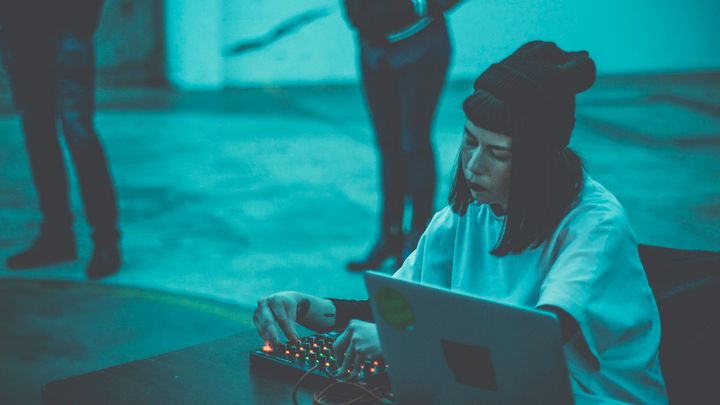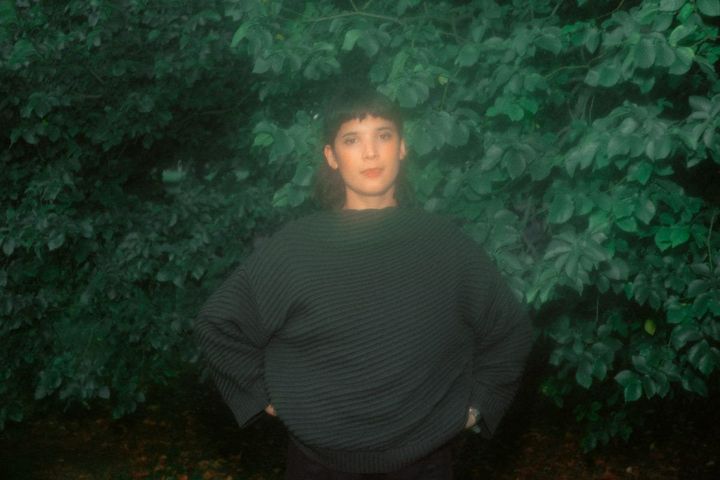Feature: Befriending Sound
In a space barely bigger than your average living room, Robert Curgenven and his audience of twenty sit surrounded by speakers in absolute pitch black. Robert himself is at the front, legs crossed, operating various Walkman CD players by light of a mobile phone, triggering drones and field recordings that creep softly in and out and wash gently over listeners; some of which who are sinking into beanbags with their eyes closed, others sat gazing contemplatively into space. Considering how minimal this music is – there are points at which the piece threatens to drop into absolute silence – it’s surprising just how intense such an experience can be when the listening environment is entirely void of distractions.
“Robert Curgenven’s work can have a very visceral effect on the body,” claims Helen Frosi, a fine artist and curator of the SoundFjord gallery at which this concert takes place. “You feel the sound as well as hear it. You’re left feeling as though you’ve had a work out as well as your ears being very happy.” There aren’t many places in the UK that provide an outlet for deep, concentrating listening experiences such as this, and in fact, London’s SoundFjord is the only one dedicated to them. Helen teamed up with sound designer Andrew Riley to open the UK’s first sound art gallery in July last year, and has since played host to a series of exhibitions, performances, lectures and workshops on the subject of sound art. She hopes that this will not only establish a community for sound artists and sound art followers, but also introduce fresh listeners to a largely neglected and misunderstood art practice. “We have people come in who are very curious about a lot of different art forms. We had one chap come in who runs a cinema, and he said, ‘I don’t know anything about sound. My background is visuals!’ He was very curious about what we were all about. So he’s come to a number of our workshops and a sound walk, and in a way, that’s what we really want – people that are curious and will bring their opinion to what we do.”

TIM YATES' "DRONE ROOM" AT SOUNDFJORD.
(c) 2011, Helen Frosi/SoundFjord. Used with permission
But of course, exposing sound art doesn’t simply depend on creating awareness in those previously oblivious – these people have to want to listen. London-based organization Sound And Music works to promote sound art and contemporary music, and acknowledges that a lack of acceptance is also apparent, as well as a lack of exposure. “I think there’s an issue with how people approach sound actually,” says SAM’s creative director, John Kieffer. “In the last 15-20 years we’ve been living within a very visually based culture – people have got very sophisticated through the visual arts and through the advertising media. They’ve got used to abstract visual images and there are big issues about people having the same level of understanding or acceptance in sound.
“As with everything else, this goes back to education in a sense. There’s a need to get children of a young age listening to a very wide range of sounds, in order to get those senses sharpened up.” And in fact, SAM are currently running a project to introduce a minute of listening at the start of the day in primary schools, at which the children are played a field recording, a noise, some music, or spoken word, in order to cultivate an acceptance of sound outside of the barriers of conventional music. “Quite often, children get it,” he says. “They haven’t got that whole canon of things they’re supposed to like or dislike, so they’ll take stuff on its own merit.”
Sound artist Martin Smith is equally keen on blowing open sound art’s insular fan-base, and believes that organizing a massive sound art event could be the way to do it. The idea is currently in the most primitive of planning stages, but Martin hopes to work alongside Helen Frosi in harnessing major sound artists across the world for what would be the first sound art exhibition since David Toop’s Sonic Boom back in 2000. “Other countries have sound art exhibitions. I don’t know why it doesn’t particularly resonate over here. I think there’s an established audience for interesting things in the UK – the Turbine Hall at the Tate has shown some interesting and bizarre work, and people have gone. I appreciate that sound art hasn’t got a massive audience, but it might be quite nice to see if we can broaden it and just let people know it’s there.”
But whilst featuring one sound-based piece in amongst a visual arts gallery is simple enough, to assemble a sound art exhibition of multiple works is a real challenge. It may be easy to exhibit several paintings simultaneously in one gallery space, but to arrange sound art in a similar format could produce cacophonous results. Martin appreciates that people often feel negatively towards sound because it doesn’t patiently sit and wait to be perceived as visual art does; it imposes on the ears without any choice on behalf of the listener – a fact that makes itself known during our interview, with the harsh hiss of traffic noise outside seeping into Martin’s Notting Hill flat. “I guess the problem with sound is the fact that it can get in people’s way. Because of the uncontrollable nature of sound, it has the potential to travel out and annoy people. I don’t want to annoy people – I want people to enjoy what I’m doing.”
This comment reminds me of New York drone minimalist Phill Niblock; in particular, his recent concert at London’s Café Oto. In a definitive demonstration of sound’s uncontrollable nature, his music left the room utterly swamped, lapping up against the corners and flooding back inwards, leaving the audience at mercy to the relentless volume and unwavering density of his 20+ minute pieces. It was a blissful experience for those who enjoy Niblock, though I can only imagine that it’d be a wholly intimidating prospect for anyone without a taste for his music – it’s one thing to be exposed to an unpleasant experience, but another to be trapped within it.

CAFE OTO
So, what if it was possible to grant the audience more control over their own listening experience? Enter the Wet Sounds Tour. While the concept of exhibiting sound art underwater in public swimming pools across the country may sound like a horrific gimmick, organizer Joel Cahen has ample reasons to confidently argue the contrary. “Underwater, the sound is perceived by your skeletal system and not so much by your ears, so it feels like the sounds are coming from inside your head. This and the lack of possible verbal communication underwater add to the isolation of the listener from hers/his surroundings, which allows for a more personal experience and immersion in the sound. The sound is very crisp and detailed, voices also sound great. The deeper you go the better the sound is.”
And yet above the water, the swimming pool remains very much a public space. Listeners can break free from the experience at any time and talk on the surface all they wish – the soundscapes operate exclusively from each other, and the music is virtually inaudible unless the listener is submerged. Unlike Phill Niblock’s sonic onslaught, Wet Sounds attendees have a very accessible route of escape and retain a degree of control over the listening experience; thus the tendency of sound to invade and impose is nullified. The feedback that Joel has received seems to imply that even strangers to sound art enjoy their time at Wet Sounds. “People who are not usually exposed to this sort of sound found it enchanting and stayed for ages. I feel this helps to loosen up their apprehension of unusual music – people get very sensitive when it comes to sound. Wet Sounds encourages them to purely listen without the cliquey social constraints of a regular sound event.”
But how can this be taken further? While Wet Sounds may offer a gentle introduction to sound art and abstract music, audiences are sold by the overall experience and not simply the sound itself; “sound” is just an aspect, or contributory factor, to the enjoyment of Wet Sounds. It’s when the sound is placed in front of listeners as the sole point of focus that uninitiated audiences can be deterred, and yet it’s difficult encourage a wider acceptance of sound art when the sound itself is perceived to only be capable of supportive roles.
“From our point of view, whether someone first hears a new sound by going to the Tate, or hearing something on BBC 3’s ‘Late Junction’ show, people will find their own way into it” asserts John Kieffer. The past two years have been important in establishing new avenues with which to do this, with Sound And Music and SoundFjord being particularly prominent forces. And while one can’t underestimate the surge of interest surrounding sound artist Susan Phillipsz taking home last year’s Turner Prize, it was an event that confirmed sound art’s acceptance within the art world and didn’t necessarily imply that the opinions of general public followed suit. Sound And Music, SoundFjord and Wet Sounds all acknowledge that it’s not necessarily a lack of promotion that’s the core cause of sound art’s “niche” status. All of them are working to cultivate entirely new ways of listening. Who knows – by the time Martin Smith’s sound art exhibition arrives, sound art could have finally achieved widespread acceptance.
SoundFjord Gallery – http://www.soundfjord.org
Sound And Music – http://www.soundandmusic.org
Martin Smith – http://www.martinasmith.co.uk
Wet Sounds – http://www.wetsounds.co.uk
Cafe Oto – http://www.cafeoto.co.uk



